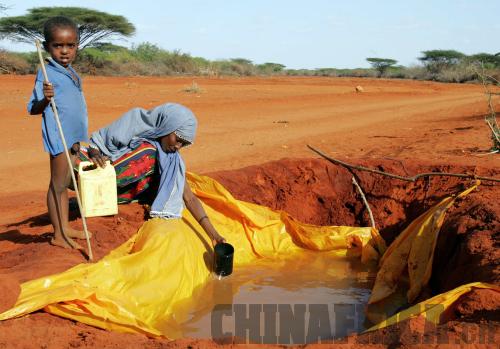|
 |
|
PRECIOUS:Every drop counts in drought stricken East Africa (Xinhua) |
New approach
In July 2011, the Kenya Red Cross Society (RCS) and the Ministry of Irrigation started a project to irrigate farms in the dry northern parts of Turkana County.
Drawing water from the perennial Keiyo and Turkwel Rivers, about 10,000 acres of drought-resistant sorghum were grown at Kalobeyei.
The Morulem Irrigation Scheme in Turkana East had collapsed several years ago leading to residents depending on relief food.
Local farmers under the supervision of the Kenyan Ministry of Water and Irrigation, through the Turkana Rehabilitation Program, did the digging for the irrigation scheme and according to the chairman, Phillip Esinyon, 18,000 people are benefiting.
"The basic thing will be to change these people's mentality that owning a cow or a goat is the only thing in life. Pastoralism is no longer helpful in these times," said Pamellah Indiaka, project development manager of RCS.
The Turkanas use livestock as a status symbol, which means that it could take longer to change their mindset. "We hope that the recent events of drought will be a catalyst [for a change in outlook]," said Dr. Mary Kimani of the Institute for Policy Research and Analysis.
(Reporting from Kenya)
Africa's Climate Change at a Glance
While the exact nature of the changes in temperature, precipitation, and extreme events is not known, there is agreement about the following general trends:
> Climate change scenarios for Africa indicate future warming across the continent, ranging from 0.2 degrees Celsius per decade (low scenario) to more than 0.5 degrees Celsius per decade (high scenario).
> Changes in rainfall will affect the presence and absence of vector- and water-borne pathogens. For example, it can be expected that small changes in temperature and precipitation will boost the population of disease-carrying mosquitoes and result in increased malaria epidemics.
> Economic activities of pastoralists will have to change because they can no longer move with their cattle to densely populated wetlands. It is no longer viable to keep large numbers of animals.
> About 80 percent of snow on mountains of Kilimanjaro (Tanzania), Kenya and Ruwenzori (Uganda) is disappearing; rivers dependent on these are also drying.
(Source: Center for African Development Solutions) |